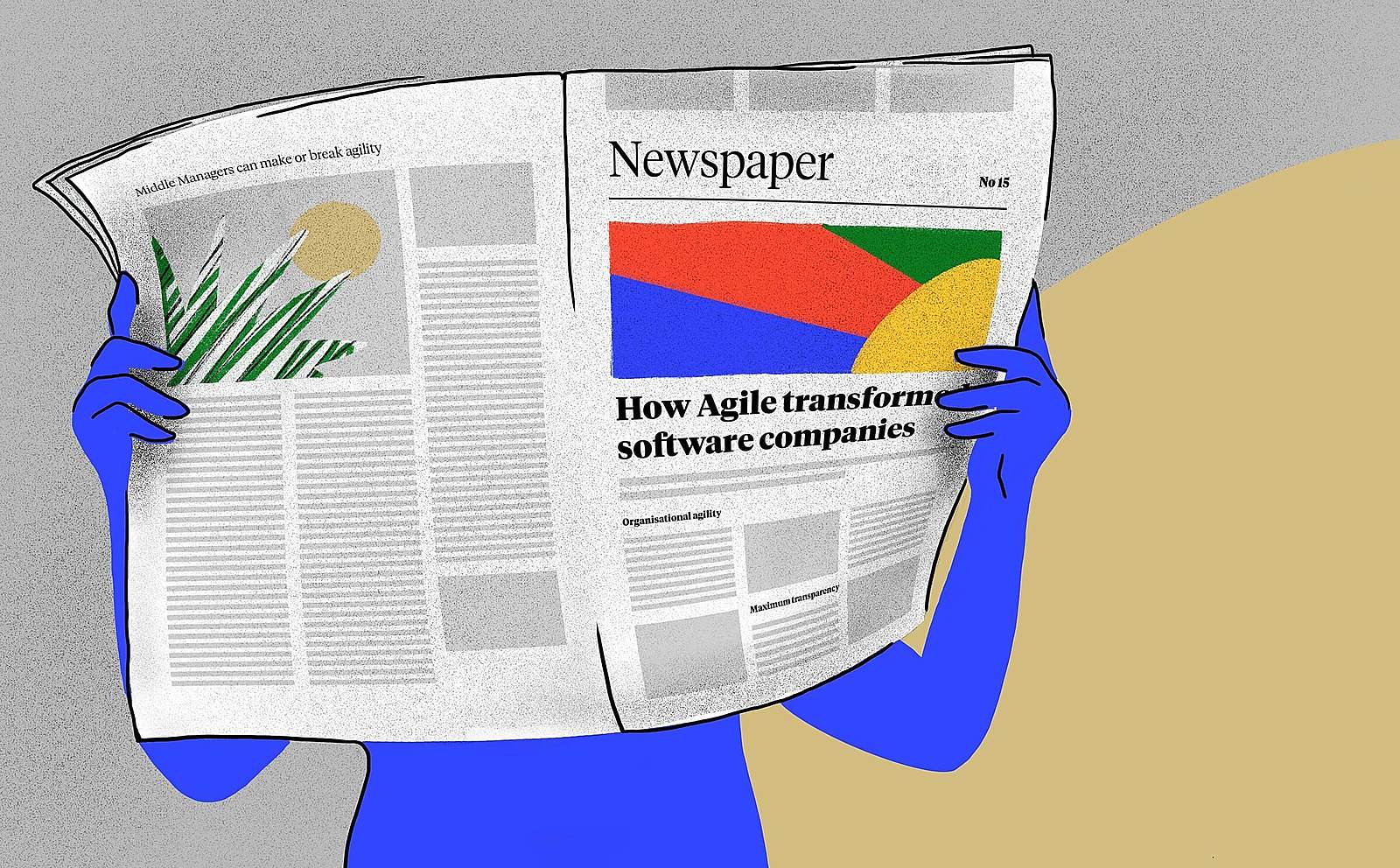A journey started by the two founders in 2005 has been an incredible, at times bumpy ride full of learning, adapting, and improving along the way.
Approaches to project methodologies changed rapidly, and we needed to keep up with global trends. During the last couple of years, we witnessed traditional waterfall projects fade away, increasingly clearing way for projects guided by agile values.
Working in an agile way has become industry-standard
Although we had prior experience working in an agile setup, we knew we had to dive deeper into the topic to analyze the benefits we could harvest, not only at the project level but also at the organizational level. We formed a team of agile practitioners to construct a long-term plan for a company-wide agile transformation.
As our business model is providing design and development services to our clients, we usually don’t single-handedly decide how we’re going to work. It has always been a collaborative, team decision.
We like to look at our clients as our collaborators – we’re all on the same team, building a digital product together.
We’ve had clients approach us with no previous experience and knowledge in software development. They had this fantastic idea, and we had the resources to help them build it. Our clients rely on our expertise in designing and developing software, so the logical step for us was to offer them consulting and coaching services about the project methodology.
Our task was to transfer knowledge about good practices and values we’ve adopted over the years.
The “agile” buzzword
To understand our approach, let’s start with some of the key agile values, like transparency, ownership, collaboration, or iterative development. These aren’t just nice-to-have buzzwords, but rather the keywords to a healthy way of building any digital product.
In addition to the company processes, the most important part about working together with our clients is collaboration. We usually discuss the client’s vision, and then finding the best solution for working together.
With regard to the above mentioned values, this collaborative way of working is focused on:
- Dialogue – A healthy dialogue between the Infinum team and our clients
- Client involvement – Iterative development with the client involved regularly
- Ownership – The team showing ownership of the product and thriving to improve the product in both functional and non-functional ways
- Identifying, communicating, and mitigating risks early
- Reacting – Swiftly reacting to the rapidly changing global market
- Understanding – Understanding our client’s needs, their vision, and their expectations
- Transparency – Transparency providing insights to the client on what we do by giving them access to our agency & project management tool, Productive
Agile is all about people, and letting the clients know they’re not alone on this journey. With this new vision, we switched from the product-centric approach of building a product for the client to building the product together.
Agile transformation on the organizational level
I’ve seen companies try to transform their way of working by introducing Scrum to a single team to see how it goes. For starters, Scrum isn’t a tool that will magically solve all problems. On the contrary – it will shine a light on the existing cracks. With a backlog of problems to begin with and no one to solve them, you’re bound to fail.
And so companies do. After a bumpy ride and mostly negative results, most companies put Scrum under lock and key and declare it Something we tried, but didn’t work for us. Of course it didn’t work!
Scrum puts you in the driver’s seat, but doesn’t teach you how to drive
Hit the highway on your first run and you’re bound to crash at some point. Go little by little and you’ll get there at some point. Similarly, to start an agile transformation on the company level, the first step is to have support from your executives. You know, the people in charge of the company’s vision.
If that vision doesn’t include agile values, there are only 2 possible outcomes:
- Try fitting in agile values in the vision
- Don’t change the vision, try agile another time
Being agile means working in a certain mindset
You can’t expect a single team to adopt the agile way of working and deliver more value out of nowhere if they’re part of a non-agile system. To conduct transformational change, everyone has to be on board. It’s a systematic approach that will impact the whole company, and not only project or product teams.
When we set out on our agile journey, our first goal was to get support from our management. We started by defining goals that will benefit Infinum and focused these benefits on our clients.
We defined 4 core goals that we wanted to start with, and slowly but surely started changing and adapting our way of working to reflect them:
- Maximum transparency
- Improved ownership
- Improved estimates
- Iterative delivery
Our executive management was on board. We got the green light.
Middle managers can make or break agility
After getting the support of our executive management, the next goal was to get everyone from the project management team on board. This is something that I’ve seen companies fail at very often.
These middle managers often get lost in their new roles and responsibilities because they usually don’t have enough knowledge, courage or even time to adapt to this new way of working. Education, mentoring, and coaching is important, because one wrong turn can result in the whole journey going downhill.

Education is key
We started with a bi-weekly community of practice workshops, mandatory for all members of the team. We discussed agile, the Scrum framework, Scrum Master, and Product Owner as roles and various other agile-related topics. The result? Everyone started feeling comfortable in this new way of working. They were asking questions – to which we often did not have the answers right away.
Sometimes it took us weeks to think of a way to solve a certain challenge, only to try it out, see it fail, scrape it, and start over. It was a learning process for all of us. To tackle day-to-day challenges, team members who had the most agile development experience were assigned as coaches, as a support role to help out other colleagues when necessary.
After a few months of education and amazing engagement from all team members, we were ready to start piloting this new way of working.
We discussed this new way of working with our clients and began defining improvements together. Starting only with a few projects and few clients, we learned a lot on the way to completely adapting all our project teams to the agile mindset.
That process has evolved significantly in the last 3 years, and will continue evolving in the foreseeable future.
Always delivering maximum value to clients
We’re working in a fast-paced global environment that requires adaptability regularly. Agile software development seems to be the way to go at the moment, so we will continue building on that.
While we’re flexible in our approach, our goal will always stay the same – deliver maximum value to clients when building their digital products.











